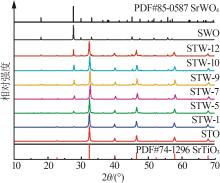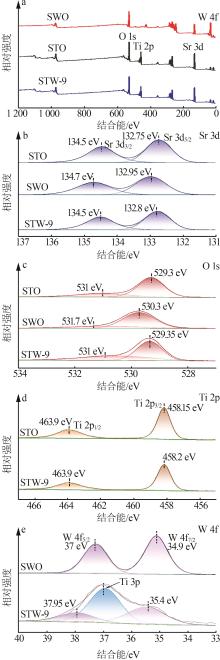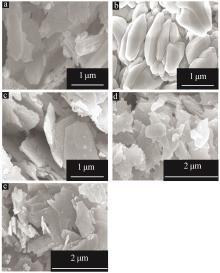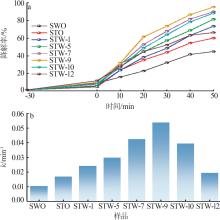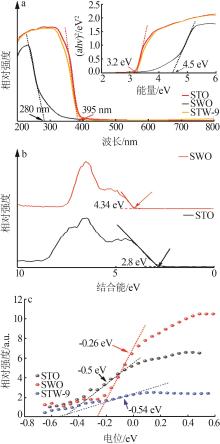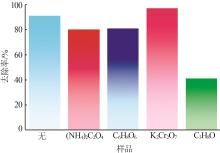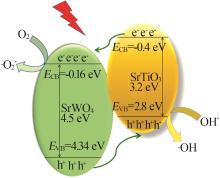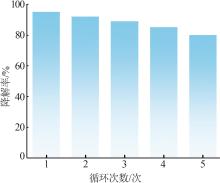Inorganic Chemicals Industry ›› 2024, Vol. 56 ›› Issue (7): 143-149.doi: 10.19964/j.issn.1006-4990.2023-0562
• Catalytic Materials • Previous Articles Next Articles
Study on preparation and photocatalytic performance of SrTiO3-SrWO4
WANG Yawen1( ), WANG Fangfang1, GENG Siyu2, JU Jia1, CHEN Lei1, CHEN Changdong1(
), WANG Fangfang1, GENG Siyu2, JU Jia1, CHEN Lei1, CHEN Changdong1( )
)
- 1.School of Petrochemical Engineering, Liaoning Petrochemical University, Fushun 113001, China
2.Jiangsu SaraMike Technology New Materials Co. , Ltd. , Zhangjiagang 215600, China
-
Received:2023-11-26Online:2024-07-10Published:2024-08-01 -
Contact:CHEN Changdong E-mail:1807679379@qq.com;chencd1984@gmail.com
CLC Number:
Cite this article
WANG Yawen, WANG Fangfang, GENG Siyu, JU Jia, CHEN Lei, CHEN Changdong. Study on preparation and photocatalytic performance of SrTiO3-SrWO4[J]. Inorganic Chemicals Industry, 2024, 56(7): 143-149.
share this article
| 1 | GUO Bobo, GU Yufen.Preparation of an excellent Z-type SrWO4@Bi2WO6 heterojunction photocatalyst and its photocatalytic performance under simulated sunlight[J].ChemistrySelect,2021,6(34):9199-9210. |
| 2 | ILINOIU E C, PODE R, MANEA F,et al.Photocatalytic activity of a nitrogen⁃doped TiO2 modified zeolite in the degradation of reactive yellow 125 azo dye[J].Journal of the Taiwan Institute of Chemical Engineers,2013,44(2):270-278. |
| 3 | HUANG S T, LEE W W, CHANG Jialin,et al.Hydrothermal synthesis of SrTiO3 nanocubes:Characterization,photocatalytic activities,and degradation pathway[J].Journal of the Taiwan Institute of Chemical Engineers,2014,45(4):1927-1936. |
| 4 | YANG Liuxin, CHEN Zhou, ZHANG Jian,et al.SrTiO3/TiO2 heterostructure nanowires with enhanced electron⁃hole separation for efficient photocatalytic activity[J].Frontiers of Materials Science,2019,13(4):342-351. |
| 5 | 孙海杰,程圆,田源,等.BiOI/g-C3N4催化剂的制备及其光催化降解罗丹明B性能[J].无机盐工业,2023,55(8):36-44. |
| SUN Haijie, CHENG Yuan, TIAN Yuan,et al.Preparation of BiOI/g-C3N4 catalyst and its photocatalytic degradation performance of Rhodamine B[J].Inorganic Chemicals Industry,2023,55(8):36-44. | |
| 6 | 谭冲,王欢欢,李俊生,等.钨掺杂钛酸锶纳米粒子的合成及其光催化性能研究[J].分子科学学报,2020,36(5):391-397. |
| TAN Chong, WANG Huanhuan, LI Junsheng,et al.Synthesis and photocatalytic activity properties of tungsten doped SrTiO3 nano⁃particles[J].Journal of Molecular Science,2020,36(5):391-397. | |
| 7 | KIRAN K S, SHASHANKA R, LOKESH S V.Enhanced photocatalytic activity of hydrothermally synthesized perovskite strontium titanate nanocubes[J].Topics in Catalysis,2022.Doi:10.1007/s11244-021-01558-2. |
| 8 | KIMIJIMA T, KANIE K, NAKAYA M,et al.Solvothermal synthesis of SrTiO3 nanoparticles precisely controlled in surface crystal planes and their photocatalytic activity[J].Applied Catalysis B:Environmental,2014,144:462-467. |
| 9 | LI Junfang, BAI Hua, YI Wencai,et al.Synthesis and facet⁃dependent photocatalytic activity of strontium titanate polyhedron nanocrystals[J].Nano Research,2016(5):1523-1531. |
| 10 | HOSSAINIAN H, SALAVATI-NIASARI M, BAZARGANIPOUR M. |
| Photodegradation of organic dye using strontium tungstate spherical⁃like nanostructures;synthesis and characterization[J].Journal of Molecular Liquids,2016,220:747-754. | |
| 11 | GUPTA S K, SUDARSHAN K, GHOSH P S,et al.Luminescence of undoped and Eu3+ doped nanocrystalline SrWO4 scheelite:Time resolved fluorescence complimented by DFT and positron annihilation spectroscopic studies [J].RSC Advances,2016,6(5):3792-3805. |
| 12 | SRIDHAR C, SAHU N, SEO Y S,et al.Comparative electrochemical,photocatalytic,and photoluminescence studies in SrWO4 and rGO-SrWO4 nanocomposites[J].Journal of Electronic Materials,2023,52(6):3759-3773. |
| 13 | 黄曦瑶,李明春,郭银彤.g-C3N4/Bi/Bi2WO6光催化材料的协同改性研究[J].无机盐工业,2022,54(12):133-138. |
| HUANG Xiyao, LI Mingchun, GUO Yintong.Study on synergistic modification of g-C3N4/Bi/Bi2WO6 photocatalyst[J].Inorganic Chemicals Industry,2022,54(12):133-138. | |
| 14 | ZHENG Mingjie, CHEN Zhixing, Yongkun LUN,et al.Hybridization of SrTiO3 and strontium wolframates with very⁃high⁃potential photogenerated carriers for degrading the A-ring of tetracycli⁃ne[J].Applied Surface Science,2021,570:151138. |
| 15 | CHEN Changdong, IKEUCHI Y, XU Linfeng,et al.Synthesis of[111]- and{010}-faceted anatase TiO2 nanocrystals from tri⁃titanate nanosheets and their photocatalytic and DSSC performances[J].Nanoscale,2015,7(17):7980-7991. |
| 16 | 常帅康,刘闯,李坤宸,等.介观TiO2晶体材料的拓扑转变合成及其性能[J].辽宁石油化工大学学报,2023,43(1):27-31. |
| CHANG Shuaikang, LIU Chuang, LI Kunchen,et al.Preparation of TiO2 mesocrystals by topochemical conversion and their performance[J].Journal of Liaoning Petrochemical University,2023,43(1):27-31. | |
| 17 | HUANG Min, ZHANG Shuyi, GAN Yongping,et al.Effective SrWO4/TiO2 heterojunction with enhanced carriers separation and transfer for photocatalytic methane oxidation[J].Chemistry,2023,29(24):e202204031. |
| 18 | WANG Fangfang, CHEN Changdong, WANG Wei,et al.Internal field engineering of WO3 by ion channel migration with enhanced photocatalytic oxygen evolution ability[J].Journal of Materials Chemistry A,2021,9(3):1678-1691. |
| 19 | YANG Zhaoming, KANG Minglang, CHEN Lei,et al.Interfacial engineering over tungsten oxide by constructing Z-scheme interatomic junction for efficient photocatalytic tetrachlorophenol degradation[J].Applied Surface Science,2023,609:155306. |
| 20 | WANG Fangfang, YANG Zhaoming, YANG Zhanxu,et al.Graphene triggered hole activation strategy for 2D/2D-layered (001)/(100) WO3 facet junction towards enhanced photocatalytic water oxidation kinetics[J].Chemical Engineering Journal,2022,450:138166. |
| 21 | 张若男,何仕婕,王晓蓉,等.BaTiO3-TiO2复合体的软化学制备及其性能研究[J].石油化工高等学校学报,2022,35(4):46-51. |
| ZHANG Ruonan, HE Shijie, WANG Xiaorong,et al.Study on soft chemistry preparation and performance of BaTiO3-TiO2 composites[J].Journal of Petrochemical Universities,2022,35(4):46-51. | |
| 22 | LEE Siaw Foon, Jimenez Relinque EVA, ISABEL Martinez,et al.Effects of Mott⁃Schottky frequency selection and other controlling factors on flat⁃band potential and band⁃edge position determination of TiO2 [J].Catalysts,2023,13(6):1000. |
| [1] | SHI Wangfang, ZHANG Yongsheng. Study on NO x degradation performance of concrete-based non-metallic boron doped nitrogen-rich carbon nitride [J]. Inorganic Chemicals Industry, 2025, 57(3): 116-123. |
| [2] | LI Zihan, ZHANG Jiaqi, LI Shizhuo, LI Xinyu, LIU Shaozhuo, WANG Yihao, HAO Yucui, LIU Jian, LI Yanhua. Study on synthesis and catalytic mechanism of CdS/g-C3N4 composite photocatalyst [J]. Inorganic Chemicals Industry, 2025, 57(3): 124-132. |
| [3] | SUN Qinghao, LI Keyan, GUO Xinwen. Study on photocatalytic benzyl alcohol oxidation coupled with hydrogen production over Pd/ZnIn2S4 nanosheets [J]. Inorganic Chemicals Industry, 2025, 57(1): 113-119. |
| [4] | LIU Guangming. Study on photocatalytic and mechanical properties of C3N5/NH2-MIL-125(Ti) modified concrete mortar [J]. Inorganic Chemicals Industry, 2025, 57(1): 120-128. |
| [5] | ZHANG Feigang, LIU Zhongli. Study on application of CuO/g-C3N4 composites in organic dye degradation and supercapacitors [J]. Inorganic Chemicals Industry, 2025, 57(1): 129-136. |
| [6] | ZHANG Guoqiang, RONG Xilin, XIAO Zhenfang, XUE Ziran, CHENG Hao, FENG Jun, LIU Quan, LU Yao, HUANG Wenyi. Study on preparation and photocatalytic properties of bagasse carbon aerogels loaded with zinc oxide nanoparticles [J]. Inorganic Chemicals Industry, 2024, 56(8): 131-138. |
| [7] | LIU Min, HUANG Xiu, ZHANG Liyuan. Research progress of S-type heterojunction photocatalysts [J]. Inorganic Chemicals Industry, 2024, 56(7): 18-27. |
| [8] | LI Jiangpeng, ZHANG Huibin. Synergistic degradation of methylene blue by photo-Fenton and photocatalytic with 3D porous LaFeO3/CeO2/SrTiO3 [J]. Inorganic Chemicals Industry, 2024, 56(5): 141-148. |
| [9] | DI Lu, WANG Weiguo, CHEN Juexian, WU Chuanshu. Study on preparation of transition metal-supported Silicalite-1 zeolite catalyst and its catalytic performance for furfural hydrogenation [J]. Inorganic Chemicals Industry, 2024, 56(4): 125-132. |
| [10] | TANG Bei. Preparation of ZnO/g-C3N4 heterojunction photocatalytic material and its degradation of pyridine [J]. Inorganic Chemicals Industry, 2024, 56(4): 133-142. |
| [11] | HUANG Jianan, LU Xiaoyu, WANG Mitang. Effect of Ba-La co-doping on degradation of methylene blue dye by TaON [J]. Inorganic Chemicals Industry, 2024, 56(2): 146-151. |
| [12] | WANG Ruirui, ZHU Chaoliang, MU Bing, MA Wanxia, FAN Jie, XU Guowang, SHI Yifei, DENG Xiaochuan, QING Binju. Preparation of cubic manganese carbonate by hydrothermal method and its application in extraction of lithium [J]. Inorganic Chemicals Industry, 2024, 56(12): 94-103. |
| [13] | ZUO Guangling, WANG Minghui, PENG Yunying, DU Jia, YE Hongyong. Study on hnoneycomb-like LaVO4/Bi2O3 heterojunction for photocatalytic degradation of tetracycline hydrochloride [J]. Inorganic Chemicals Industry, 2024, 56(11): 158-164. |
| [14] | CUI Xiangdong, LIU Sile. Study on photoelectric performance analysis of g-C3N5 nanorods and removal of Cr(Ⅵ) and methylene blue [J]. Inorganic Chemicals Industry, 2024, 56(10): 159-168. |
| [15] | YAN Yu, ZHOU Wenyuan, YANG Yunfei, WU Junshu, WANG Jinshu, SUN Lingmin. Study on surface regulation of sodium ferric silicate photocatalyst and its enhanced Cr(Ⅵ) photoreduction properties [J]. Inorganic Chemicals Industry, 2024, 56(10): 141-150. |
| Viewed | ||||||
|
Full text |
|
|||||
|
Abstract |
|
|||||
|
||
